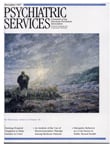To the Editor: In subtyping delusional disorder, the authors of
DSM-IV did not include a litigious variant, although the syndrome had been previously described (
1). It is thought to be both rare and resistant to treatment, especially when related to an organic condition, in which case a diagnosis of psychotic disorder due to a general medical condition would be appropriate. This report describes the successful treatment of a litigious delusional patient with pimozide.
Mr. A, a 52-year-old Caucasian male, began exhibiting litigious delusions at age 51, about a year after his father's death. He falsely believed that his sister, attorneys, and judges conspired to deny him his share of his father's estate, and he had hired and fired nine attorneys in his efforts to claim imaginary missing funds. He wrote numerous letters to state and federal authorities charging unfair treatment by the courts and made death threats toward his sister that resulted in his arrest. He was found incompetent to stand trial and subsequently was hospitalized.
Mr. A had a premature and difficult birth. He was deaf since age 2, secondary to streptomycin treatment for an infection; developed conduct disorder at age 13; and abused alcohol from age 20 to age 40. He developed a grand mal seizure disorder at age 39. When he was 40, during the course of the work-up after his first seizure, a 5 cm left frontal lobe meningioma was diagnosed and resected. He had been maintained on anticonvulsant therapy and remained free of seizures since his surgery. His most recent CT scan, at age 50, showed no regrowth of the meningioma or other abnormalities.
On his initial mental status examination after hospitalization, Mr. A was clear and logical in his thinking and oriented to person, time, and place. However, his affect was constricted, and he had prominent paranoid litigious delusions. An MRI revealed a 3 cm venous angioma in the right posterior temporal lobe.
Mr. A was initially given prolixin, but it was discontinued after four weeks due to intolerance. He then was started on pimozide 2 mg per day, gradually titrated to 6 mg per day.
After five weeks Mr. A's symptoms substantially resolved. He no longer considered pursuing litigation or writing letters to various state and federal authorities, although he still felt that he was cheated of his share of the estate. He no longer threatened his sister and was discharged. He was subsequently linked to aftercare treatment and, six months later, had not been readmitted to our facility.
The meningioma and the anginoma may have contributed to Mr. A's illness. To our knowledge, this is the first reported case in which a patient with litigious delusions that appear to be associated with medical conditions has responded well to pimozide. Ungvari and Hollokoi (
2) reported using pimozide to successfully treat an 85-year-old litigious patient who suffered with the illness for 40 years without any medical conditions.
Numerous publications show that pimozide successfully treats various types of delusional disorders, including litigious delusions. Its unique mechanism of action is largely devoid of noradrenergic impact; it does not block postsynaptic D
2 receptors, while having relatively little impact on D
2 autoreceptors. Further studies to determine the usefulness of pimozide in delusional disorders associated with other organic conditions are desirable in view of the unique features in pimozide's neuropharmacological profile (
3).

